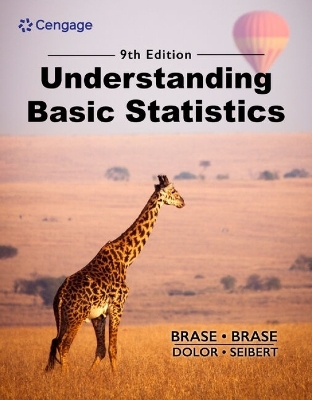
Understanding Basic Statistics
Brooks/Cole (Verlag)
978-0-357-75735-2 (ISBN)
Charles Brase has more than 30 years of full-time teaching experience in mathematics and statistics. He taught at the University of Hawaii, Manoa Campus, for several years and at Regis University in Denver, Colorado, for more than 28 years. Dr. Brase received the Excellence in Teaching award from the University of Hawaii and the Faculty Member of the Year award from Regis University on two occasions. He earned degrees from the University of Colorado, Boulder, and he holds a Ph.D. and an M.A. in mathematics and a B.A. in physics. Corrinne Pellillo Brase has taught at Hawaii Pacific College; Honolulu Community College; and Arapahoe Community College in Littleton, Colorado. She was also involved in the mathematics component of an equal opportunity program at the University of Colorado. Professor Brase received the Faculty of the Year award from Arapahoe Community College. She earned her degrees from the University of Colorado, Boulder, and she holds an M.A. and a B.A. in mathematics. James Seibert has more than 20 years of full-time teaching experience in mathematics and statistics. He taught briefly at Colorado State University and Willamette University, and currently teaches at Regis University in Denver, Colorado, where he has been a professor for the last 21 years. Dr. Seibert was mentored at Regis by Dr. Charles Brase, and remained life-long friends with Dr. and Ms. Brase. Dr. Seibert earned his B.A. in mathematics with minors in physics and philosophy from Linfield College and his M.A. and Ph.D. in mathematics from Colorado State University. Jason Dolor has more than 16 years of teaching experience in mathematics and statistics. He taught briefly at the University of Guam and has been serving as a teacher and researcher at Portland State University and the University of Portland for the last 15 years. Dr. Dolor regularly publishes his work in research journals. He also presents his work in statistical thinking, teacher knowledge, educational technology, curriculum development and assessment at various education conferences. Dr. Dolor earned his B.S. in computer science from the University of Portland, a graduate certificate in applied statistics, an M.S. in mathematics and a Ph.D. in mathematics education from Portland State University. Jason Dolor has more than 16 years of teaching experience in mathematics and statistics. He taught briefly at the University of Guam and has been serving as a teacher and researcher at Portland State University and the University of Portland for the last 15 years. Dr. Dolor regularly publishes his work in research journals. He also presents his work in statistical thinking, teacher knowledge, educational technology, curriculum development and assessment at various education conferences. Dr. Dolor earned his B.S. in computer science from the University of Portland, a graduate certificate in applied statistics, an M.S. in mathematics and a Ph.D. in mathematics education from Portland State University.
1. GETTING STARTED.
What Is Statistics? Random Samples. Introduction to Experimental Design.
2. ORGANIZING DATA.
Frequency Distributions, Histograms, and Related Topics. Bar Graphs, Circle Graphs, and Time-Series Graphs. Stem-and-Leaf Displays.
3. AVERAGES AND VARIATION.
Measures of Central Tendency: Mode, Median, and Mean. Measures of Variation. Percentiles and Box-and-Whisker Plots.
4. CORRELATION AND REGRESSION.
Scatter Diagrams and Linear Correlation. Linear Regression and the Coefficient of Determination.
5. ELEMENTARY PROBABILITY THEORY.
What Is Probability? Some Probability Rules-Compound Events. Trees and Counting Techniques.
6. THE BINOMIAL DISTRIBUTION AND RELATED TOPICS.
Introduction to Random Variables and Probability Distributions. Binomial Probabilities. Additional Properties of the Binomial Distribution.
7. NORMAL CURVES AND SAMPLING DISTRIBUTIONS.
Part I: Graphs of Normal Probability Distributions. Standard Units and Areas under the Standard Normal Distribution. Areas Under Any Normal Curve. Part II: Sampling Distributions. The Central Limit Theorem. Normal Approximation to Binomial Distribution and to p ^Distribution.
8. ESTIMATION.
Estimating µ When s Is Known. Estimating µ When s Is Unknown. Estimating p in the Binomial Distribution.
9. HYPOTHESIS TESTING.
Introduction to Statistical Tests. Testing the Mean µ. Testing a Proportion p.
10. INFERENCES ABOUT DIFFERENCES.
Tests Involving Paired Differences (Dependent Samples). Inferences about the Difference of Two Means µ1 - µ2. Inferences about the Difference of Two Proportions p1 - p2.
11. ADDITIONAL TOPICS USING INFERENCE.
Part I: Inferences Using the Chi-Square Distribution.
Overview of the Chi-Square Distribution. Chi-Square: Tests of Independence and of Homogeneity. Chi-Square: Goodness of Fit. Testing a Single Variance or Standard Deviation.
Part II: Inferences Relating to Linear Regression.
Inferences for Correlation and Regression.
| Erscheinungsdatum | 03.01.2023 |
|---|---|
| Verlagsort | CA |
| Sprache | englisch |
| Maße | 217 x 277 mm |
| Gewicht | 1270 g |
| Themenwelt | Mathematik / Informatik ► Mathematik ► Statistik |
| Wirtschaft | |
| ISBN-10 | 0-357-75735-1 / 0357757351 |
| ISBN-13 | 978-0-357-75735-2 / 9780357757352 |
| Zustand | Neuware |
| Haben Sie eine Frage zum Produkt? |
aus dem Bereich


